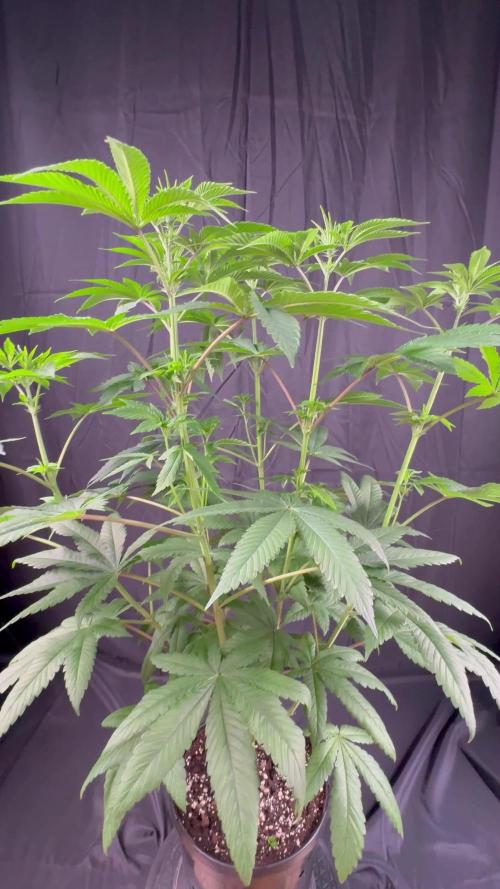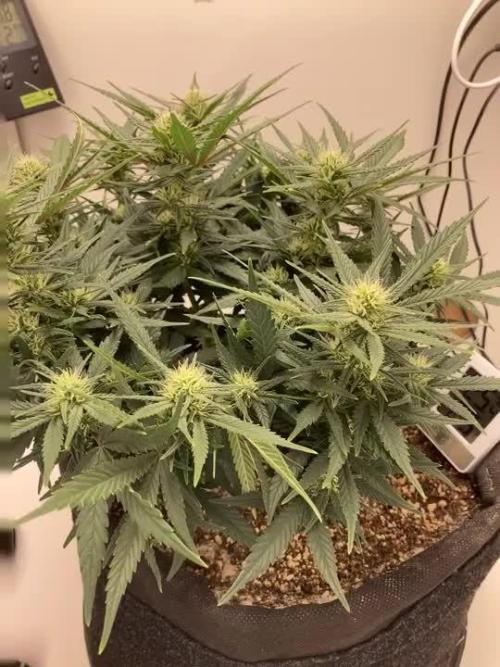The Grow Awards 2026 🏆 































Likes
39
Share


@eldruidamx
Follow
Day 92. Watering with fertilizers.
Day 93. Watering with clean water.
Day 94. Watering with fertilizers.
Day 95. Watering with clean water.
Day 96. Watering with fertilizers.
Day 97. Watering with clean water.
Day 98. Watering with fertilizers.
Likes
34
Share


@MrJoint
Follow
✌️🎃 Thank you for checking my cultivation.
🌺 They seem to have liked defoliation.
Likes
16
Share


@Lazuli
Follow
So the smallest of the 3 got harvested,
Now the yellow plant goes another week
While the final plant needs 2 more weeks maybe 3weeks
Likes
10
Share


@TiRobotProds
Follow
Forte odeur de fruits exotique se dégage de ces dames, elle sont bien givré etle rinçage a commencé.
Likes
11
Share


@Luv2Grow
Follow
Day 57 - Starting week 9 and she was ready for a feeding of water and nutes today, so she got almost 2 full gallons. I did do a very light defoliation with her today as well and she’s definitely liking the second AGLEX light turned on and seems like it’s helping her plump up quite a bit.
Day 58 - Just trimmed up a few of the larger fan leaves hanging in the way of the buds and just letting her go otherwise. She’s frosty as hell and gonna have some fat and dense buds when all is said and done.
Day 61 - All going well still and looking like she’s down to the last couple weeks as well. Will start monitoring her trichs from here on out. She wasn’t quite ready for water yet but should be tomorrow. Flowers are looking amazing as frosty as hell.
Day 62 - Not much I need to do with this girl anymore, just feeding her when she needs it and that’s about it. She did get about a gallon and a half of plain water today and it’s looking like she’s only got a couple weeks left.
Day 63 - The end of week 9 and just letting this girl do her thing and her trichs will tell me when she’s ready. The buds are nice and compact already and figure they can only get better the next 2-3 weeks. Not much I can or really need to do with her right now.
Likes
Comments
Share


@Shoeless31
Follow
All caught up. Transplanted into 3 gallon pots. Lightly watered with some calmag and recharge
Roots were good and just about ready for the upgrade. No pics but I’ll keep this in mind for my next grow and take some. I know I looked on here and watched YouTube videos to see how was done and it has been very helpful
Likes
14
Share


@CanarianGrow92
Follow
First week of flowering and its going great! The plants are still nice and green from the biogrow we gave some weeks ago, next steps is to give some guanokalong bloom nutrients and a small shot of green sensation from plagron!
Processing
Likes
7
Share


@RunWithIt
Follow
Actually kind of glad the light fell on her two weeks back - right before flower and you can tell she's about to bush out. I've been diligently defoliating and tying her down at each developing node. Every day i seem to be greeted by new growth. In other words, she responds great in high stress situations!
I may top my new Purple Lemonade purposefully since this one responded so well.
Not much else to say... God speed fellow growers!!
Likes
12
Share


@CampaCavallo
Follow
3ª Settimana di Fioritura 💐
Ok Amici della Canapa 💚
16.12.24
È stato installato il nuovo LED di Spider🕷️Farmer ☀️... Bello e ben fatto! Spero sia anche efficiente 👍🏻
La LEMON OG 🍋🌊 di SSSC 💜🐘💜 è propio bella sotto la luce della SF2000 ☀️
Likes
41
Share


@Santica_Garden
Follow
Alien OG looking amazing, my best grow by far but I still could have done so much better, but it's a part of improving, learning as I'm growing 😅. Really excited to try this out, 2 of the ladies I will start flushing on their next feed. 👍🏾
Likes
8
Share


@sevengreenfingers
Follow
Hello everyone! I promised to track this grow very closely this time and ufortunately life got in the way. Here is a quick sumup of the grow.
First of all- One of the sour stomper plants unfortunately didn't make it. It died at about week 4. The main stem somehow had rubbed/broken down. That's why it was falling down. It was almost like a mini beaver had chewed it off at the point where the stem touches the riot rooter. At first I thought nothing much of it, maybe it hasn't been rooted in quite well yet or something. And I was constantly touiching it when watering, that made it worse. Soo the leaves were dropping and the plant looked very weak. Then I decided cut thr rapid rooters top layer and found out the severity of the problem. Tried to tape it up and other things, but it was too late. At the end it appeared all good as the remaing plants got so big the I had some space issue so I wouldn't have been able to fit another plant in anyway.
At that time I finally made my self-draining saucers. I took me a while and a lot of effort, but finally they were ready and working well. I also installed the self watering system and flowering was starting. Pretty soon I started noticing weird leaf symtoms. Brown spots, different kind. Some plants had it more, some less. Sour Stomper looked pretty good throughout the grow. Mango smiles seemed sensitive and Strawberry Nuggs were pretty strong until the end.
The grow was basically me experimenting with the setup- changing watering schedules , changing ppm, ph and all that stuff to keep the leaves looking healthy and it was very hard I have to admit. Probably my hardest grow in that regard. But somehow, the bud leaves remained healthy and the buds really fattened up good. I got away with an amzing 700G dry bud harvest which was def a new record from one grow. And the bud quality is very good too!
Next time definetly no more than 4 plants as they got pretty big and I thought it was a little overcrowded. I was doing some good defoliation too. I should have defolited strawberry nugs more tho. Sour Stomper got some amazing bud development from top to bottom because it was was growing next to strawberry nuggets which were really small most of the grow. They actually took the most time to harvest even longer than Mango smile. Mango smiles were ready quite early. Sour Stomper was just in time!
I topped sour stomper and both Mangoi smiles, left SNs both normal. Looking back at it, the way I grow them, Should have topped SNs too. Would probably have more space in the middle and longer side branches. Probably wouldn't have been as bushy!
I followed the full Terra aquatica feed chart until the end. I was supplementing with CalMag a lot as I thought the symptoms could have been from a CalMag deficiency as this was my first grow with RO water.
Overall a very challenging but good grow at the end. First time no mold problems. A record breaking yield for me. Basically surpassed the upper limit for all plant probable harvest sizes. Got good smelling quality bud. Very happy overall and will continue experimenting with Mephisto beans in the future for sure! I guess what I like the most about Mephisto is how close to description the plant is, very stable genes in that regard.
Next time I will also have to start feeding plants higher PPM feed faster at the very start. and during flowering. But still not 100% sure what caused the leaf symptoms.
Likes
3
Share


@Ninjabuds
Follow
The black cherry gushers has a really amazing smell I can’t put my finger on what it is but trust me. I also like the nodal spacing just a strong pretty plant for sure.
Likes
9
Share


@NanoLeaf
Follow
End of Week 8 (First week of flower)
Increased the CO2 to 1200ppm and the ladies love it, already started stretching within the first 3 days of flower which shows that CO2 definitely boosts the grow cycle of cannabis.
The main top-sites are popping up everywhere and everything looks evenly spread out. I defoliated again because the fan leaves are growing so fast and blocking bud sites. I also did one last lower canopy maintenance and removed small and stalky bud sites and stems below the trellis net to make sure I get maximum energy distribution to the main colas.
I also added some GHF BioEnhancer to make sure the soil-microbes are happy and that the plants reach their maximum potential.
Pest Report: EXTERMINATED!
Thrips VS Ladybugs VS Neem Oil...
I decided to fight fire with fire - I purchased Swirski-Mites from Koppert (They are beneficial insects that feed on the eggs and larvae of thrips and other unwanted pests). As for the adult thrips - I got very lucky and found about 10 Ladybugs in my garden and decided to introduce them into my grow room as they will feed on adult thrips and any other unwanted pests.
Then to be extra sure I know that neem oil hinders the life cycle of pests like thrips causing them to stop colonising in my grow room. So I sprayed the ladies every day during the dark period to make sure there are no pests that I or the Ladybugs have missed.
Mission accomplished. No more wilting and definitely no more thrips.
Likes
23
Share


@NorthernMonkeyzInc
Follow
Ive had to veg a little longer than i like but the girls are doing great so it is wot it is
Likes
19
Share


@Comfrey
Follow
Beginning of week 8: Tropicana is 24 cm high and the stem is 36 cm long. She is a legal frosty angel (10 degrees last night) growing on a rotten balcony in a small town in germany.
Day 50
🌥️☁️☁️ 10-19 degrees, humidity 78%
I noticed that the soil has sunk. It moved downstairs, between the drainage I guess. New pots problem.
Got my compost, summer will be long and there will be a second round for sure. So I prepared bigger pottery pots, maybe 15 liter, which will be ready for seeds in about a month or two.
Tropicana needs rainwater now, some sunny hours during the day. That’s all.
I like how she develops.
Day 51
☁️🌨️☁️☁️☁️🌦️🌈 14-19 degrees and humidity is around 77%.
I gave Tropicana too much nitrogen. Spotted some signs and stop with fertilizers for now. It‘s ok but the comfrey manure had more nitrogen than I expected. In the next days we‘ll have a lot of rain, so Tropicanas soil will be washed and this will solve the problem maybe. It‘s a big difference to grow cannabis in a pot then veggies in the ground in a no dig garden with yearly compost mulching. My Tomatoes in ground loved this 1:5 comfrey manure breakfast but for Tropicana less would have been more. Maybe 1:15 or 1:10. It always depends on the raw material for the liquid manure. This year we had a lot of rain and the comfrey had maybe more nitrogen as usually.
Day 52
🌥️🌤️🌦️🌤️ 13 - 19 degrees and the humidity is 69%. Tropicana had about 0.8 Liter pure rainwater today. It was raining the whole night.
Day 53
🌧️☁️☁️🌧️ 13-17 degrees, humidity is around 90%. Me and Tropicana have a rest. We chill with a tasty vape on the balcony while doing nothing more then chill.
Day 54
🌧️☁️☁️🌧️ 13-18 degrees, humidity is around 93%. Saturday, time for cleaning the balcony and take some fotos of my flowers.
Her smell is getting much more intensiv. I see that the color of the buds is getting diverse. The soil is moist from the rain.
Day 55
🌧️☁️☁️☁️ 13-18 degrees, humidity is falling, now 69%.
Tropicana spend the day chilling with her friends on the balcony. They talked about the weather and what to do in the next week.
Day 56
⛅️🌤️☀️🍉 12-24 degrees, humidity is around 78%
Tropicana had a sunbath for hours. I bought a cheap magnifying glass today and I‘m so happy with this one. It have 30x / 60x lenses and two LEDs. I found it in a shop for mycologists. I‘m crazy about mushroom hunting. Normal mushrooms, yes. So this is absolutely relaxing viewing the structure of fruits, my homemade soil, little insects living inside. Actually this was a tip out of a blog article of Fast Buds Tropicana Cookies week by week guide, which I can highly recommend.
I gave Tropicana in the morning a 1:20 field horsetail tee, ~ 0,7 liter in three steps. 100-200-400 milliliters. She was drinking it till sunset. The pot got lighter till evening, around half a kilo or maybe more.
Likes
18
Share


@BABS_Babies
Follow
I did a low wet trim, and saved the trimming for butter and oil. I dried in a mesh for 12 days, then kept in mason jars and burped them.


























